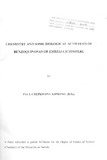| dc.description.abstract | Embelia schimperi and Embelia keniensis are among the five medicinal Myrsinaceae
plants found in Kenya which find a wide range of application in ethnopharmacology as antimicrobials
and anthelmintics. The berries and root bark of E. schimperi were extracted with
cold ethyl acetate and found to contain mostly benzoquinones. The level of benzoquinones
was found to be higher in the berries relative to root bark. Chromatographic separation of the
bioassay selected fractions on oxalic acid impregnated silica gel (soaking in 3% oxalic acid in
methanol) using various solvent systems for E.. schimperi led to the isolation and
identification of embelin (10), methylvilangin (21), myrsinaquinone (56), decylvilangin (76)
and decylanhydrovilangin (77), all of which are benzoquinones. Embelia keniensis was only
screened (with aid of TLC analysis) for the presence of the benzoquinone pigments and found
to contain trace amounts of embelin (19). All these structures were established using physical
and spectroscopic (UV, MS, IH, 13C and 2-D NMR) data. Two compounds were not
characterized.
Biological activity tests such as insect anti-feedant, brine shrimp lethality, larvicidal
and anti-microbial were carried out with the pure compounds.
Insect anti-feedant tests were determined with Locusta migratoria using a
concentration of 100 ug/ml of each sample which was applied on sucrose treated Whatman
No.1 filter paper. In the control experiments, the filter papers had sucrose only. Embelin (10)
and :u. were found to have relative anti-feedant percentage (RAP) of 96% and 33%
respectively.
The larvicidal tests were done on mosquito larvae, Aedes aegypti. Compound 21 was
the only one tested for this activity and was found to be a growth retardant.
Brine shrimp lethality test was done for ~, Z9:.KCP-01 and KCP-06. The LCso
values were found to be 120,51,54 and °ug/rnl respectively:
Stored products pests test was performed using SitoDhilus zeamais (maize weevil)
and Anthoscelides obtectus (bean weevil) for embelin (19) and it was found that the total
number of emerged progeny and reproductibility of the two insects were reduced
significantly at all concentrations.
, Anti-microbial activity test was performed using Candida albicans, Trichophvton
metagroohvte, Microsporium gypsum and Escherichia coli for 1~0, n.......,, 5~J~,7~6, 7.-7, KCP-02
and KCP-06 and it was found that all the compounds had less than significant activity against
the micro-organisms. | en |

